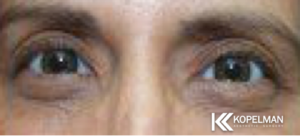The disinsertion of muscle attachments which lead to ptosis occurs most commonly as an age related change but can also occur at birth and in middle aged patients who have worn hard contact lens for long periods of time. Like an overhanging awning this downward droop leads to an obstruction of a patient’s superior field of vision.




“I first met Dr. Kopelman when I was diagnosed with a condition called Ptosis which causes dropping eyelids. He performed surgery to correct the problem and the results were outstanding. Dr. Kopelman is a caring, kind physician who treats his patients with respect. In addition, I can’t imagine finding a more skilled doctor.”
~ Gwen McCarthy ~
Ideal Ptosis Candidate
Ptosis Benefits
Ptosis Techniques
Dr. Kopelman's approach to ptosis repair will help you restore your vision and will create a more youthful appearance to your face
Frequently asked questions
about Ptosis
Because the drooped eyelids impairs your vision and can impede your daily activities it is “viewed” as a functional impairment. Your insurance carrier may cover the procedure. However, eyelid ptosis must be differentiated from excessive laxity of upper eyelid skin.
An eyelid droop must be differentiated from a laxity of the upper eyelid skin that can hang down and impinge on your field of vision. When skin hangs down and fat bulges appear then an upper eyelid blepharoplasty, a cosmetic procedure, is necessary to remove excess skin and protruding fat. At the time of your visit, Dr. Kopelman will perform a comprehensive evaluation of your drooped eyelids. He will determine if ptosis (drooped upper lid) is present alone or whether it exists concurrently with lax upper eyelid skin and bulging fat. If both eyelid muscle and skin laxity exist together then a ptosis repair and cosmetic procedure can be performed at the same time in order to achieve an optimal rejuvenated appearance. Unfortunately, the cosmetic component is not covered by your medical insurance.
Schedule a Consultation
For Ptosis Eyelid Surgery
To schedule a private consultation with Dr. Kopelman,
please call the office or request an appointment online.
Follow me around the web
Dr. Joel Kopelman is a Facial Oculoplastic Surgeon in New York City and New Jersey Performing Eyelid Surgery, Browlifts and Facelifts

Lorem ipsum dolor sit amet, consectetur adipiscing elit. Ut elit tellus, luctus nec ullamcorper mattis, pulvinar dapibus leo.